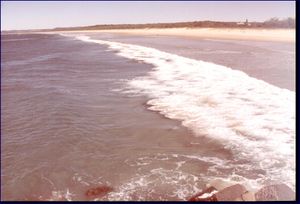Difference between revisions of "Template:This weeks featured article"
From Coastal Wiki
(→Carrying capacity analysis) |
|||
| Line 1: | Line 1: | ||
| − | == | + | ==Coastal zone characteristics== |
| + | [[Image:sandy coast.jpg|thumb|Fig. 1. Sandy coast. Source: [http://www.dhigroup.com DHI]]] | ||
| − | + | Defining the characteristics of the coastal zone will depend on the coastal type. Sand is a common marine sediment producing sandy beaches resulting from littoral transport. It is these hydrographic conditions that determine the appearance of the coastline. In environments that are fairly calm in terms of wave conditions muddy coast tend to be more dominant, in comparison rocky coasts are continually cut back by the sea. Arctic coastlines are those which are exposed to more than 6 months a year freezing. A barrier coast is formed when a lagoon separates a barrier island (which runs parallel to the shore) from the coastline. | |
| − | + | [[Coastal_zone_characteristics#Sandy beaches|Sandy beaches]] | |
| − | + | [[Coastal_zone_characteristics#Muddy coasts|Muddy coasts]] | |
| − | + | ||
| + | [[Coastal_zone_characteristics#Rocky coasts|Rocky coasts]] | ||
| + | |||
| + | [[Coastal_zone_characteristics#Arctic coasts|Arctic coasts]] | ||
| + | |||
| + | [[Coastal_zone_characteristics#Barrier coasts|Barrier coasts]] | ||
Revision as of 11:19, 21 April 2008
Coastal zone characteristics

Fig. 1. Sandy coast. Source: DHI
Defining the characteristics of the coastal zone will depend on the coastal type. Sand is a common marine sediment producing sandy beaches resulting from littoral transport. It is these hydrographic conditions that determine the appearance of the coastline. In environments that are fairly calm in terms of wave conditions muddy coast tend to be more dominant, in comparison rocky coasts are continually cut back by the sea. Arctic coastlines are those which are exposed to more than 6 months a year freezing. A barrier coast is formed when a lagoon separates a barrier island (which runs parallel to the shore) from the coastline.